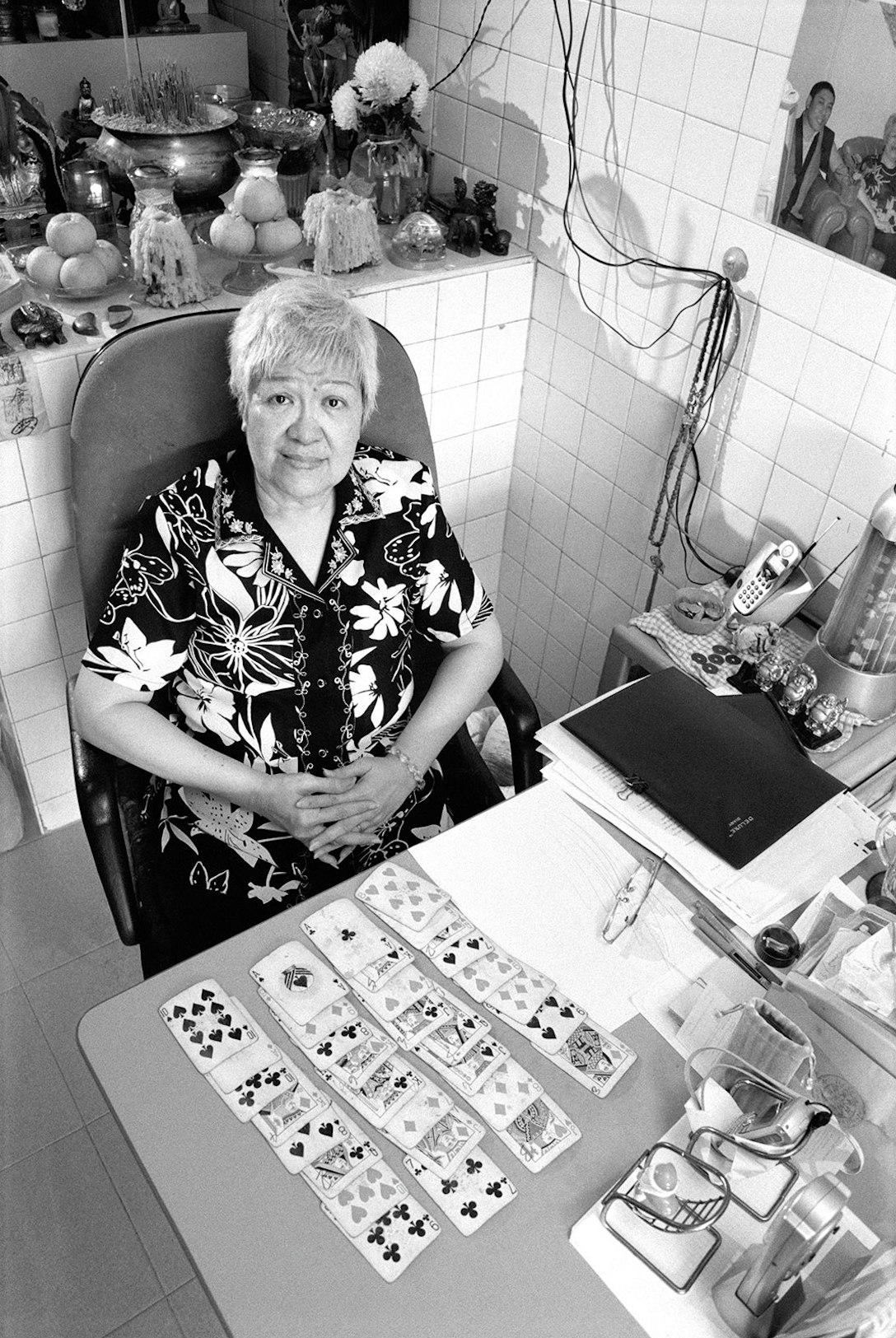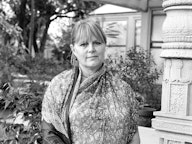
Soo Ah Gok
Republic of Singapore
THE FOUR STAGES OF LIFE
It began when I was 30 years old. Back then, I fell sick and would vomit every single night at 11:30 pm. This lasted for about three years. I consulted the doctors but they couldn’t find anything wrong with me. I was having a hard time falling asleep as well, as I had to be completely still during my sleep. Eventually I went to seek help from Som Por Sek Gak, a Thai god, who instructed me to do good deeds in order to be cured from sickness. If I didn’t, I would continue to face a lot of hardships in life in terms of physical health, and financially as well. I made a promise to Som Por Sek Gak to start doing good deeds and helping people once I was 50 years old. My son was still young at the time and I wanted to focus on raising him. I wanted him to be at least 20 years of age before I embarked on my journey to help others. I wasn’t really taught how to do it. The gods/souls would come in my dreams when I was asleep at night and they would instruct me on what to do. Sometimes, the god would also show me the future—when people asked for help to look into their future. I was appointed by Som Por Sek Gak to help him. It was fate.
Daniel’s Reflection
I met Soo Ah Gok in Singapore where she works as a healer and has helped many people overcome hardships. To understand people’s issues and futures, she makes lines with her pencil back and forth very fast on a piece of paper in a notebook, almost like reading tea leaves. She also uses playing cards to see future events and share messages, not unlike tarot cards.
She was guided to her healing work through a ceremony when she was 30 and suffering an unknown illness. The Thai god, Som Por Sek Gak, instructed her to devote her life to “good deeds” but she felt she could not do that until she had fully raised her son. It instantly reminded me of the Hindu concept of ashramas, which are the four life stages described in ancient Indian texts: Brahmacharya [student], Grihastha [householder], Vanaprastha [retired] and Sannyasa [renunciate]. It is during the period of vanaprastha, or retirement, that a person relinquishes worldly duties and begins to focus on service to others. The ultimate expression of this is the ashrama of sannyasa where a person becomes a renunciate and focuses exclusively on spiritual matters with no focus on what we would call “creature comforts.”
It is actually quite remarkable to me that a person afflicted with sickness for years, like Soo Ah Gok was, would receive a prophetic message from a god to devote herself to a life of “good deeds,” but have the understanding that this meant such a life would be outside of raising her son. This raises two questions: Must a life committed to “good deeds” wait until one is retired and able to let go of child raising and careers? Must we all proceed through all four ashramas or stages of life?
So, I consulted my dear friend, Kardama Muni Das (Carl Mink) who has been a devotee of Krishna Consciousness for over 40 years and is deeply schooled in Hindu texts. First, the good news: We do not need to advance to the more exclusively spiritually-focused stages to have a life focused on good deeds and a spiritual deepening. Kardama Muni Das said: “Sri Rupa Goswami, in his Bhakti- Rasamrta Sindhu (which was translated from the Sanskrit into English and published in summary as “Nectar of Devotion” by A.C. Bhaktivedanta Swami) describes this as follows: ‘A person acting in Krishna consciousness (or, in other words, in the service of Krishna) with his body, mind, intelligence and words is a liberated person even within the material world, although he may be engaged in many so-called material activities. He has no false ego, nor does he believe that he is this material body, nor that he possesses the body. He knows that he is not this body and that this body does not belong to him. He himself belongs to Krishna, and the body too belongs to Krishna. When he applies everything produced of the body, mind, intelligence, words, life, wealth, etc.—whatever he may have within his possession—to Krishna’s service, he is at once dovetailed with Krishna. This is the perfect stage of Krishna consciousness.’”
We can live deep spiritual lives in any stage, including when most of us have our family and careers. For example, my friend, healer Alison Boynton Ledbetter, once told me: “For some people, the spiritual path is making cupcakes for their children.”
In Judaism, there is a concept called kavanah which is the spiritual intention behind any action—you can pray by just reciting prayers, or you can recite them with true kavanah. Likewise, we can perform good deeds with or without kavanah. What matters is that we reflect that deep spiritual intention in all that we do, day in and day out. I know this is true across all the faith traditions—that the mundane can be made holy by our spiritual intention.
Regarding my second question about whether we must proceed through all four stages of life as prescribed by the ashramas (specifically, Vanaprastha, retired, and Sannyasa, renunciate), what I find so provocative is that these third and fourth ashramas make increasing our spiritual focus more intentional and not just an avocation for retirement and end of life. Kardama Muni Das reminded me that Srila Prabupadha, the revered founder of the Hare Krishnas was already 69 years of age when he traveled to the United States to begin spreading Krishna consciousness in the West. So there seems to be two schools of thought around this question of whether to formally proceed to the Vanaprastha (retired) and Sannyasa (renunciate) stages. One school of thought is represented by this beautiful quote from Srimad Bhagavatam Canto 1, Chapter 5, Verse 17:
“One who has forsaken his material occupations to engage in the devotional service of the Lord may sometimes fall down while in an immature stage, yet there is no danger of his being unsuccessful.”
So this school of thought suggests that we should attempt to advance to these more spiritually focused stages of life and that all earnest attempts will produce success.
Kardama Muni Das suggests the other school of thought that formally progressing to these advanced stages can bring frustration: “In the absence of direct order or assent from guru or without significant and sufficient impetus, changing ashrama is not required for spiritual advancement. The acharyas have written many times to the effect: ‘grhe thako, vane thako, sada hari bole dekho,’ or, ‘Whether in household life or in the forest, just always chant the Holy Name.’ One should fight from one’s own position of relative strength. Everyone is different; everyone’s psycho-social nature is different. Sometimes a change is just the thing. Yet, I have seen many productive persons change their dress and mode of activity only to meet with frustration and challenges where before their progress was uninterrupted. There is no loss in making an honest attempt to please the Lord, and yet the impetus to change a situation that is productive and steady should be examined with care. Advancement in spiritual life is the thing. What is the right position for you? Ultimately, you will take guidance from Krishna, Who is seated in your heart and Who knows your desires.”
It seems that we are encouraged to forsake material occupations when we can and feel called to do so. What if we in the Western world were to begin seeing service to others and spiritual development as our sole focus (or at least a primary focus) in retirement and old age, especially now when human beings live longer? If Prudential Insurance is right with their marketing campaign (“Let’s Get Ready For A Longer Retirement”) maybe we all need to reconsider how we spend our longer retirements. Personally, I am deeply motivated to devote more of myself outside of my marketing consulting work to spiritual healing and a more contemplative- centered life. I hear similar intentions from other friends and colleagues who want a more deliberate opportunity to heal themselves and serve others.
Soo Ah Gok’s interview reminded me to be deliberate and to have a sacred intention in all stages and in all activities of life.
REFERENCES & PERMISSIONS
Bhaktivedanta Swami Prabhupada, A.C. His Divine Grace. The Nectar of Devotion:
The Complete Science of Bhakti-yoga. (The Nectar of Devotion is Srila Prabhupada's summary study of Bhakti-rasamrita-sindhu, or “The Ocean of the Pure Nectar of Devotional Service,” by Rupa Goswami, a direct disciple of Chaitanya Mahaprabhu.)
Source: http://www.krishna.com/books/the-nectar-of-devotion
Srimad Bhagavatam, Canto 1, Chapter 5, Verse 17. www.http://vedabase.net/sb/1/5/17/en3
Explore the portraits by theme
- happiness
- grief
- faith
- addiction
- sexuality
- sobriety
- transgender
- alcoholism
- suicide
- homelessness
- death
- aggression
- cancer
- health
- discipline
- abortion
- homosexuality
- recovery
- connection
- enlightenment
- indigenous
- depression
- meditation
- therapy
- anger
- forgiveness
- luminaries
- interfaith
- worship
- salvation
- healing

